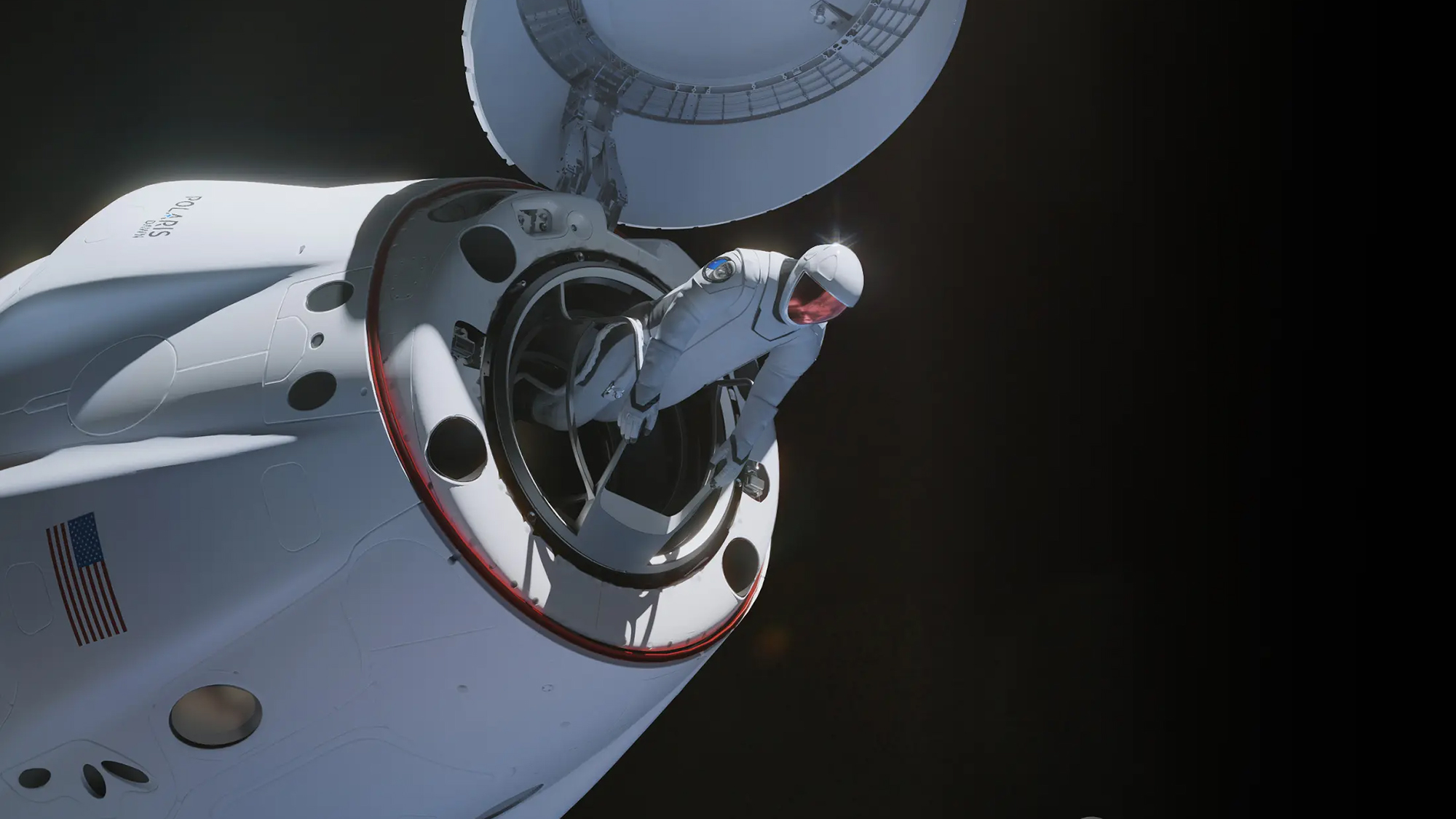
An illustration of the upcoming space mission. Polaris Program
This month, the burgeoning era of private spaceflight takes a big step forward. SpaceX is set to launch Polaris Dawn, its second all-civilian mission (after Inspiration4 in 2021) and the first in their Polaris program.
Originally announced in 2022, Polaris Dawn is designed to push the limits of SpaceX’s technology and help pave the way for a longer-term human presence in space. It’s the first of three missions funded by billionaire Jared Isaacman, who also bankrolled Inspiration4. Although its launch date has been pushed back a few times over the years, it is now set to launch no earlier than July 12, 2024 according to a recent interview with Isaacman.
The mission’s plans include the first commercial spacewalk, ambitious research on human health in space, tests to equip the spacecraft with Starlink WiFi, and reaching a high orbit over 800 miles above Earth—the furthest out a human has gone from our planet since the Apollo era. SpaceX sees the mission as an early pathfinder for their Starship spacecraft, an ambitious science-fiction-esque project intended to carry hundreds of humans to orbit, the Moon, and perhaps even Mars.
Polaris Dawn will use the SpaceX Crew Dragon capsule to carry four team members to space: Isaacman, former Air Force lieutenant colonel Scott “Kidd” Poteet, and SpaceX engineers Sarah Gillis and Anna Menon. This crew will spend around five days in orbit around Earth, flying so high above our planet that it’ll actually pass through the van Allen radiation belts, rings of energetic particles trapped in Earth’s magnetic field. No one has gone through the van Allen belts since the Apollo program ended in the early 1970s.
The Polaris Dawn crew plans to take advantage of that fact and will collect medical data to better understand how that radiation environment impacts the people traveling through it. They’ll also take on an array of other health research, including measuring the gas bubbles in their blood to study decompression sickness (colloquially known as “the bends”).
One of the wildest experiments, however, aims to understand “spaceflight associated neuro ocular syndrome” or SANS. This is “one of the biggest challenges associated with long duration spaceflight,” explained Poteet in an interview with NASASpaceflight Live. When an astronaut is in microgravity, the pressure of their spinal fluid—all the goo surrounding your brain and important nerves like those in your spine and eyes—changes, sometimes resulting in disconcerting symptoms like blurry vision. The crew will be measuring this pressure with some non-invasive techniques, but Poteet also hopes to be the guinea pig for the first invasive measurement of spinal fluid pressure in space, where he would have a measuring mechanism surgically implanted before flight.
That won’t be the biggest first for the mission, however. Polaris Dawn plans to attempt the first spacewalk ever done on a private mission—that is, the first one done outside the realm of NASA or another government agency. The first NASA spacewalk happened back in 1965 on Gemini IV, when astronaut Ed White spent 21 minutes outside his spacecraft. Since then, spacewalks have become a regular part of operations on the International Space Station, and have even been used to repair the Hubble Space Telescope on a Space Shuttle mission.
The Polaris Dawn crew will gear up in SpaceX’s newly designed EVA suits to keep them safe from the deadly vacuum of space, where they’ll spend about two hours on the whole process of getting outside and getting back in the spacecraft. Historically, NASA’s spacesuits have been a bulky affair, very limited in who can actually wear them. SpaceX’s goal is to make an EVA suit that is more flexible—literally and figuratively—to make the experience of a spacewalk more accessible to a range of heights and body types, with the eventual goals of “a base on the Moon and a city on Mars” according to their website. “We’re trying to inspire people to think about this extraordinary world we could live in tomorrow where we have people living on Mars,” said Isaacman on the Today show.
Last but not least, the mission aims to test Starlink—SpaceX’s satellite-based internet—from a spacecraft, as a way to provide internet connectivity even away from Earth. Similar to Inspiration4, the mission is also raising funds for St. Jude Children’s Hospital, and Mennon will stream herself reading her children’s book while in orbit to hopefully inspire kids’ interest in science.
For all these ambitious goals, the crew has now been training for a few years, from skydiving to high altitude mountaineering, and even centrifuge training à la NASA astronauts. Even if they’re ready to go to space, however, the launch date depends most strongly on the technology to actually get them there—and there is definitely a chance the mission’s launch gets pushed back again beyond this month. But whenever it does lift off, this is sure to be a milestone in humanity’s quest to venture further into space and will provide useful information for planning future endeavors.“We want to share lessons learned with everyone,” said Poteet on NASASpaceflight Live. “This is about allowing all of humanity to be involved, to get to the Moon, to get to Mars.”
>>> Read full article>>>
Copyright for syndicated content belongs to the linked Source : Popular Science – https://www.popsci.com/science/spacex-polaris-dawn-spacewalk/